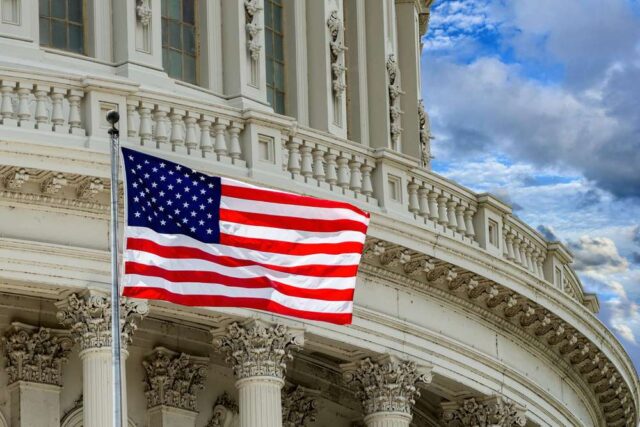TL;DR
- The Bitcoin for America Act would let Americans pay federal taxes in Bitcoin and route those inflows into a Strategic Bitcoin Reserve.
- Supporters claim this could strengthen the U.S. balance sheet, but those projections rely on optimistic modeling and assume steady BTC appreciation.
- The bill is thin on statutory detail and leaves major gaps in custody, compliance, AML screening, revenue stability, and IRS infrastructure—making execution far more complex than the proposal suggests.
Rep. Warren Davidson’s Bitcoin for America Act (H.R.6180) proposes one of the boldest integrations of cryptocurrency into U.S. fiscal policy so far. The bill would let individuals and businesses pay federal taxes in Bitcoin, then route those assets into a long-term Strategic Bitcoin Reserve. Supporters argue that steady “sovereign DCA” could strengthen America’s balance sheet and reduce reliance on inflation-prone debt. Yet the numbers used to justify these claims rely on optimistic modeling. The bill also introduces operational, regulatory, and fiscal complexities that could overwhelm the benefits. Innovative or not, the proposal raises questions about whether the U.S. government can actually run a system like this at scale.
What the Bitcoin for America Act Actually Proposes
At its core, the Bitcoin for America bill makes two major changes. First, it allows taxpayers to send Bitcoin directly to the IRS to settle federal obligations. The valuation would be determined at the time of transfer, and the contribution would count as a non-recognition event. This means taxpayers using appreciated BTC to pay what they owe would not trigger capital gains. For individuals who already calculate their obligations in digital assets, this would help reduce friction and create a clearer framework for how Bitcoin tax payments would work in practice.
The second part of the bill channels all Bitcoin tax payments into a Strategic Bitcoin Reserve. This reserve builds on the Trump administration’s executive order that consolidated seized Bitcoin rather than auctioning it. Under the proposal, the reserve would operate with long holding periods, a strict annual sales cap, and a mandate to treat Bitcoin as a strategic monetary asset. With these rules in place, the bill seeks to create a U.S. Treasury Bitcoin reserve designed to compound over decades, not serve short-term budget needs.
However, one issue stands out immediately: this Bitcoin Act is unusually thin in terms of actionable statutory language. Much of the text reads more like a policy paper than a conventional bill. It offers narrative, justification, and macro-level argument but lacks the detailed amendments and procedural clauses that normally integrate legislation into the U.S. Code. This does not make the proposal unserious. Yet it signals that congressional staff, and likely Treasury and IRS technical teams, would need to rewrite much of it before it could operate as functional law.
The Case for a Fiscal Hedge
Supporters argue that the U.S. balance sheet needs alternatives. Federal deficits remain high, interest expenses continue to rise, and reliance on debt exposes the government to inflation cycles and elevated yields. For this group, Bitcoin’s fixed supply and predictable issuance schedule make it a long-term hedge against monetary debasement.
Much of the enthusiasm comes from modeling by the Bitcoin Policy Institute. Their projections assume that even a small share of taxes, even as little as 1 percent, paid in Bitcoin could accumulate several million BTC over two decades. Because the reserve structure relies on voluntary contributions, the bill avoids the optics and market disruption of direct government buying. It becomes a market-driven reserve mechanism rather than a top-down acquisition program.
These ideas fit into the broader landscape of Bitcoin policy legislation, where lawmakers have tried to integrate digital assets into fiscal planning without aggressive state purchases.
The Gap Between Modeled Upside and Real-World Constraints
The optimistic numbers circulating around the proposal rely on assumptions that may not hold. Many projections treat long-term Bitcoin appreciation as a near certainty and downplay Bitcoin volatility risk. However, they rarely consider the impact of BTC price cycles on tax revenue, which becomes critical if part of federal intake arrives in a volatile asset.
Revenue Volatility
The government relies on stable revenue patterns to budget for spending and emergency actions. If the IRS begins accepting Bitcoin, revenue projections become tied to market cycles. Strong inflows during bull markets could vanish in down cycles. This instability weakens the claim that the reserve strengthens the balance sheet, since the government has almost no control over timing.
Budget Scoring Uncertainty
The Congressional Budget Office evaluates how policies affect revenues and deficits. When taxpayers pay federal taxes in Bitcoin instead of selling BTC for dollars, capital gains tax events disappear. That erases taxable revenue the government would otherwise collect. As a result, budget scoring for cryptocurrency policy becomes unusually difficult. The reserve may gain assets, but Treasury may lose traditional revenue.
Liquidity Mismatch
A long-term reserve cannot support short-term needs. The proposal’s 20-year horizon and strict sales cap limit the government’s ability to use the reserve flexibly. This mismatch means Bitcoin might improve the balance sheet on paper while contributing little to fiscal resilience during downturns.
The Operational Realities the Bill Doesn’t Resolve
Beyond fiscal questions, the bill introduces several practical issues that require major infrastructure upgrades across Treasury and the IRS.
Custody and Security
The government does not operate a scalable system for holding large amounts of digital assets. Creating one would require extensive upgrades in key management, hardware security modules, chain-of-custody processes, and external partnerships. Creating one would require major upgrades in key management, hardware security modules, chain-of-custody processes, and multiple external partnerships. In practice, this is a question of how the Treasury can handle custody and security for digital assets, an area where federal infrastructure is still limited.
AML and Sanctions Compliance
Accepting Bitcoin tax payments means screening UTXOs before acceptance. Tainted coins create legal and operational emergencies. Regulators also need clear protocols for rejected payments. These operational challenges for Bitcoin tax intake in America remain unresolved.
Small-Business Friction
For small businesses, crypto volatility is not an abstraction. If firms calculate quarterly obligations in dollars but pay taxes in Bitcoin, timing becomes critical. Rapid swings can distort liabilities. Some companies would also struggle with tax compliance when handling crypto, especially small businesses that must manage accounting rules, payroll integration, and reconciliation.
Administrative Complexity
IRS systems were not built to process, timestamp, and reconcile digital-asset payments. Integrating these processes into existing frameworks would require extensive changes to IRS cryptocurrency rules and internal workflows. These issues remain separate from broader questions about federal crypto regulation, which still lacks clear long-term direction.
The Political and Strategic Context
The bill sits within a broader GOP effort to position the United States as a leader in digital-asset strategy. It follows earlier proposals from Sen. Lummis and Rep. Donalds that aimed to formalize federal Bitcoin reserves and clarify custody requirements. The Strategic Bitcoin Reserve aligns with this vision and presents the U.S. as competing with other nations in accumulating strategic digital assets.
However, the proposal’s legislative path is uncertain. Even crypto-friendly lawmakers may hesitate to support a bill that relies on volatile revenue flows, introduces administrative burdens, and requires significant new infrastructure. In a divided Congress, advancing a bill that would reshape tax intake is challenging.
>>> Read more: France Bitcoin Reserve Bill Faces Political Test
Conclusion — Innovation vs Implementation
The Bitcoin for America Act is one of the most ambitious attempts to integrate Bitcoin into sovereign finance. It offers a compelling narrative about long-term reserves, fiscal diversification, and taxpayer optionality. Yet the proposal is thin on statutory detail and heavy on conceptual framing. The gaps between vision and execution remain large. The idea may be directionally interesting, but the real test is whether policymakers can transform this essay-like proposal into a statute that works in practice.










